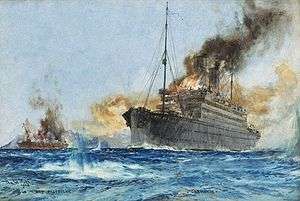Merchant raider

Merchant raiders are armed commerce raiding ships that disguise themselves as non-combatant merchant vessels.
History
Germany used several merchant raiders early in World War I (1914–1918), and again early in World War II (1939–1945). The most famous captain of a German merchant raider, Felix von Luckner, used the sailing ship SMS Seeadler for his voyage (1916–1917). The Germans used a sailing ship at this stage of the war because coal-fired ships had limited access to fuel outside of territories held by the Central Powers due to the Allied Blockade of Germany.
Germany sent out two waves of six surface raiders each during World War II. Most of these vessels were in the 8,000–10,000 long tons (8,100–10,200 t) range. Many of these vessels had originally been refrigerator ships, used to transport fresh food from the tropics. These vessels were faster than regular merchant vessels, which was important for a warship. They were armed with six 15cm (5.9 inch) naval guns, some smaller guns, torpedoes, reconnaissance seaplanes and some were equipped for minelaying. Several captains demonstrated great creativity in disguising their vessels to masquerade as allied or as neutral merchants. Kormoran sank the Australian cruiser Sydney in one of the most well-known episodes involving merchant raiders during World War II.
Italy intended to outfit four refrigerated banana boats as merchant raiders during World War II (Ramb I, Ramb II, Ramb III and Ramb IV). Only Ramb I and Ramb II served as merchant raiders and neither ship sank enemy vessels. The New Zealand cruiser Leander sank Ramb I off the Maldives (February 1941); Ramb II sailed to the Far East, where the Japanese prevented her from raiding, ultimately took her over and converted her to an auxiliary transport ship. (Ramb III served as a convoy escort and Ramb IV was converted for the Italian Royal Navy to a hospital ship.)
These commerce raiders carried no armour because their purpose was to attack merchantmen, not to engage warships. Also it would be difficult to fit armour to a civilian vessel. Eventually most were sunk or transferred to other duties.
The British deployed Armed Merchant Cruisers in World War I and in World War II. Generally adapted from passenger liners, they were larger than the German merchant raiders.
During World War I, the British Royal Navy deployed Q-ships to combat German U-boats. Q-ships were warships posing as merchant ships so as to lure U-boats to attack them; their mission of destroying enemy warships differed significantly from the raider objective of disrupting enemy trade.
See also
- Armed merchantmen
- Auxiliary cruiser Atlantis
- Auxiliary cruiser Kormoran
- Auxiliary cruiser Möwe
- Auxiliary cruiser Wolf II
- List of Japanese auxiliary cruiser commerce raiders
- Prize (law) - admiralty law concerning material captured
- Q-ship
External links
- Merchant Ships Convert Into War Raiders, Paint And False Structures Provide Disguises September 1941 article details how Merchant Raiders operate in wartime
- Marauders of the Sea, German Armed Merchant Raiders During World War 1, Wolf
- Marauders of the Sea, German Armed Merchant Raiders During World War 1, Möwe
- Hilfskreuzer